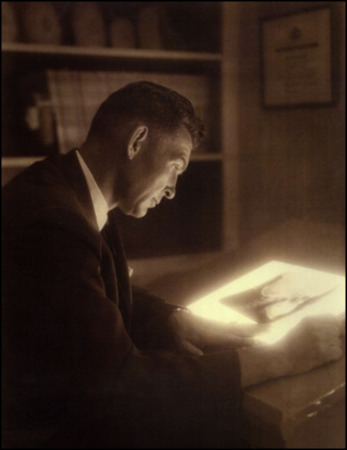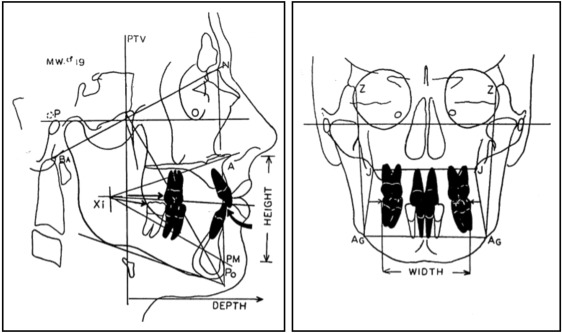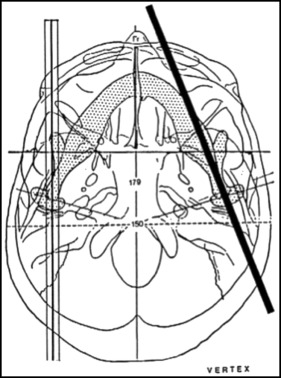
In the sciences, scholars emerge from time to time to lay down principles and crystallize the information of their day. Such a scholar was Dr Robert Murray Ricketts (1920-2003) ( Fig 1 ). His influence continues to contribute to our understanding of the biologic and mechanical enigmas that challenge us. His writings stimulate the student and promote advancements in his beloved specialty of orthodontics. Dr Ricketts commanded leading-edge knowledge and was a pioneer in early treatment and facial orthopedics, temporomandibular joint tomography and therapies, esthetics and golden proportions, orthodontic sectional biomechanics with biologic and physiologic emphases, lateral and frontal facial analysis ( Fig 2 ), asymmetry, nutritional influences, airways, world conditions, music and the arts, anthropology, and more.


Robert Ricketts began his life humbly on a farm in Indiana, where unswerving persistence and achievement were expected and valued. He credited “the farm” for his work ethic, quick laughter, and earthy sense of humor. In that community he was an accomplished athlete, but once he decided to pursue a career in dentistry, he forged himself into a determined, accomplished scholar.
In January 1943, when Ricketts was in dental school at Indiana University, the world was at war; young doctors served in the military, and Dr Ricketts was no exception. LTJG Ricketts served in the U.S. Navy Dental Corps; during this time, he became fascinated with orthodontics. In 1947, when his service was concluded, he enrolled at the University of Illinois under Dr Allan G. Brodie, who had been an early student of Edward H. Angle, so the curriculum emphasized the edgewise technique. Ricketts wrote: “Dr. Brodie had the most exceptional proclivity to instill in his students a sense of the importance of orthodontics in their lives and to our whole culture. He expressed a love and respect for the profession.”
Ricketts earned his master’s degree from the University of Illinois Graduate School of Orthodontics in 1950.
Clinician and preceptor
After Ricketts’ orthodontic training, Dr Cecil Steiner encouraged him to move to Pacific Palisades, California, to start his practice. The practice flourished, and in 1959 Ricketts agreed to serve as a preceptor for Dr Ruel Bench, who joined the practice as a partner in 1970 and went on to lecture with Ricketts. Dr James Hilgers joined them in their clinic as well. In 1977, Ricketts and Bench amicably ended their practice partnership, and Ken Fischer and Richard Jacobsen joined it.
During those busy years of practice and teaching, Ricketts was honing his bioprogressive technique and appliances. Bioprogressive differs greatly from traditional edgewise, Begg, and straight-wire philosophies in terms of the possibility doctrine and the modalities attending to it (rather than thinking with a doctrine of limitations).
He inspired and challenged other professionals to learn about biologic and progressive approaches to treatment. He developed key professional relationships and followers on all continents. He collected patient records and gradually convinced colleagues about his new-found approaches, innovations, and reliable results. He established the American Institute of Bioprogressive Education and was instrumental in establishing the Foundation for Orthodontic Research. Today, the Modern Bioprogressive Organization ( www.bioprogressive.org ) provides a portal for debates and a place to share research and keep the principles alive. New technologies and materials have been integrated to develop hyperefficient orthodontic clinical therapies and biomechanical procedures to drive treatment to greater excellence.
Ricketts freely used the proceeds from his private practice to help finance his other endeavors, including a lengthy career in university and original research. He authored over 300 refereed articles, chapters, and textbooks on orthodontics, all derived from and paid for from his private practice, with support from Rocky Mountain Orthodontics, and personally thereafter.
Areas of interest and accomplishment
Ricketts was a noted authority and expert in craniofacial anatomy, physiology, and human facial development. He was a pilgrim of curiosity and inspired newness of the orthodontic eye, mind, passion, and soul. Some of his accomplishments include the following.
- •
Challenging the specialty to learn and understand facial anatomy and its growth with orthopedic influences on treatment decisions and biomechanics.
- •
Recognizing orthopedic potential and challenging us to “treat faces, not teeth”; he emphasized jaw orthopedics and selective cervical headgear for orthopedic correction.
- •
Developing a hierarchy of anchorage with recognition that facial growth, muscles, cortical anchorage, and tooth-based anchorage prevail in biomechanics.
- •
Developing a “root rating” scale to quantify optimal light forces to move teeth in any plane of space.
- •
Advancing temporomandibular joint (TMJ) analysis, imaging techniques, and jaw dysfunction therapies.
He stressed individualized treatment planning, keeping the planned outcome in mind. For his work, he received numerous national and international awards, including the Ketcham and Mershon Awards from the American Association of Orthodontists, a Merit Award from American Society of Dentistry for Children, awards in oral surgery, and a doctor of nutrition degree.
Although his interests were wide-ranging, he was perhaps most intensely interested in orthodontic innovations, the biology of occlusion, facial analysis and treatment predictions, TMJ anatomy, and stomatognathic dysfunction therapies. He analyzed total patient issues and recognized that function precedes form, since it influences the biology of living and dynamic tissues—a paramount concept for contemporary orthodontists as true physicians of the face. In his 1-week comprehensive TMJ course, Ricketts vigorously taught the important biologic functions of human craniomandibular articulation and mechanical homeostasis for reflexes of the neuromuscular system. His work in this area lasted 43 years, and he produced 3 books devoted to orthodontic and TMJ topics.
By 1990, he had treated 6000 patients with temporomandibular disorders. The Ricketts’ biotemplate was his most used “splint.” He championed orthodontic corrections with occlusally supported results as the most stable. He helped to develop the sectograph for corrected TMJ tomography ( Fig 3 ); it could show TMJ space, structural surface changes, and limits of adaptability in the joint. He taught about muscular input derived from normal occlusion and function to help preserve the joint and create equilibrium.





